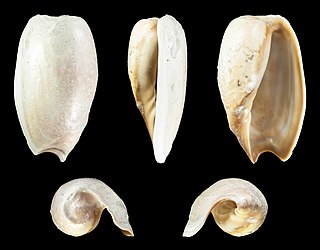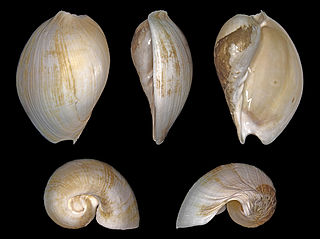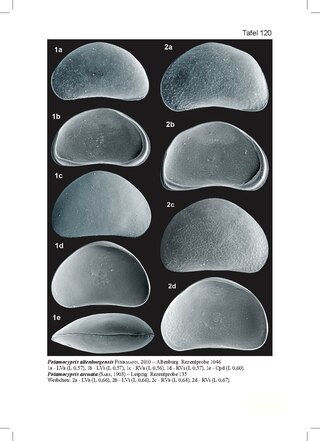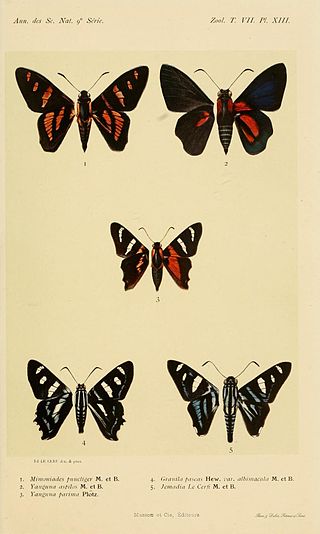
Alphonse Milne-Edwards was a French mammalogist, ornithologist, and carcinologist. He was English in origin, the son of Henri Milne-Edwards and grandson of Bryan Edwards, a Jamaican planter who settled at Bruges.
Palaeocursornis is a monotypic genus of pterosaurs. The only known species, P. corneti, was described in 1984 based on a single bone interpreted as the distal part of a left femur, found in Early Cretaceous (Berriasian rocks from a mine at Cornet near Oradea in northwestern Romania. It was initially assumed to be a flightless paleognathe bird, possibly a ratite, and later as a more primitive ornithuromorph or non-avialan theropod. However, re-evaluation of the specimen suggested that it was not a femur at all, but the upper arm bone of a pterodactyloid pterosaur similar to Azhdarcho.
Acastellina is a genus of minute trilobites in the order Phacopida, which existed in what is now Germany. It was described by Richter and Richter in 1954. The type species is Acastellina nolens, originally described as a species of Acastella.

Léopold Nicolas Reichling was a Luxembourg biologist and naturalist.

Paramysis is a genus of mysid crustaceans (Mysidacea) in family Mysidae, distributed in coastal zone of low boreal East Atlantic Ocean, Mediterranean Sea and the basins of Black Sea, Sea of Azov and Caspian Sea.

Theodore Wells Pietsch III is an American systematist and evolutionary biologist especially known for his studies of anglerfishes. Pietsch has described 72 species and 14 genera of fishes and published numerous scientific papers focusing on the relationships, evolutionary history, and functional morphology of teleosts, particularly deep-sea taxa. For this body of work, Pietsch was awarded the Robert H. Gibbs Jr. Memorial Award in Systematic Ichthyology by the American Society of Ichthyologists and Herpetologists in 2005. Pietsch has spent most of his career at the University of Washington in Seattle as a professor mentoring graduate students, teaching ichthyology to undergraduates, and curating the ichthyology collections of the UW Burke Museum of Natural History and Culture.

Cymbium pachyus, commonly known as the dilated baler volute, is a species of sea snail, a marine gastropod mollusc in the family Volutidae, the volutes.

Cymbium tritonis is a species of sea snail, a marine gastropod mollusc in the family Volutidae, the volutes.

Neoglyphea inopinata is a species of glypheoid lobster, a group thought long extinct before Neoglyphea was discovered. It is a lobster-like animal, up to around 15 centimetres (5.9 in) in length, although without claws. It is only known from 17 specimens, caught at two sites – one at the entrance to Manila Bay in the Philippines, and one in the Timor Sea, north of Australia. Due to the small number of specimens available, little is known about the species, but it appears to live up to five years, with a short larval phase. A second species, previously included in Neoglyphea, is now placed in a separate genus, Laurentaeglyphea.
Potamocypris is a genus of ostracod crustaceans in the family Cyprididae. There are currently 44 extant species of Potamocypris. The majority of the species occur in freshwater habitats; only a few species of the genus colonize marine brackish coastal waters.

Potamocypris mastigophora is a species of ostracod crustacean in the family Cyprididae, subfamily Cypridopsinae. It is known from Africa and the southern areas of the Palaearctic.
Potamocypris steueri is a species of ostracod crustaceans in the family Cyprididae, subfamily Cypridopsinae found in marine brackish waters of the Mediterranean Basin as well as in brackish coastal waters of the Black Sea and the Caspian Sea.
Potamocypris variegata is a species of ostracod crustaceans in the family Cyprididae, subfamily Cypridopsinae. It is mainly found in ponds with rich aquatic vegetation, more rarely in slowly flowing streams. The species is distributed throughout Europe, but is also known from North America.
Potamocypris smaragdina is a species of ostracod crustacean in the family Cyprididae, subfamily Cypridopsinae. It is known from both Europe and North America.

Potamocypris arcuata is a species of ostracod crustacean in the family Cyprididae, subfamily Cypridopsinae. It is mainly known from the southern areas of the Palaearctic.

Ocypode fabricii is a species of ghost crabs endemic to the coast of northern and western Australia, from Darwin to Shark Bay. They are medium-sized ghost crabs with a squarish body. The carapace reaches a length of 38 mm (1.5 in) and a width of 40 mm (1.6 in). Like other ghost crabs, one of their claws is much larger than the other. They live in burrows in the intertidal zones of the muddy to sandy beaches of mangrove forests.

Eugène Anatole Auguste Victor Boullet was a French naturalist, entomologist and collector.
Paraperipatus lorentzi is a species of velvet worm in the Peripatopsidae family. This species is a dark green-blue. Females of this species have 22 to 28 pairs of legs; males have 21 or 22 pairs of legs. Whereas the original description of this species records 19 mm as the length of a male specimen, females range from 33 mm to 60 mm in length. The type locality is in Western New Guinea, Indonesia. The validity of this species is uncertain: Although some authorities deem P. lorentzi to be a junior synonym of P. papuensis, a similar species also found in Western New Guinea, others recognize them as two separate species.

Gothus is a genus of crab in the family Xanthidae, known from the Indo-West Pacific. The genus comprises two species, Gothus consobrinus and the type Gothus teemo.











